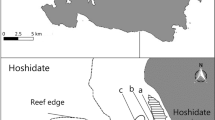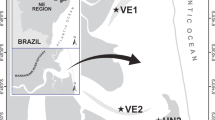Abstract
Since the substantial loss of subtidal eelgrass (Zostera marina L.) in the 1930s, seagrass beds in the Wadden Sea are limited to the intertidal zone and dominated by Z. noltii Hornem. This study deals with the effect of vegetated tidal flats on quantities of mobile epifauna and proves empirically the function of seagrass canopies as a refuge for marine animals remaining in the intertidal zone at ebb tide. Drop-trap samples were taken in the Sylt-Rømø Bight, a shallow tidal basin in the northern Wadden Sea, on vegetated and unvegetated tidal flats during July and August 2002, and during the entire growth period of Z. noltii from May to September in 2003. The species composition in Z. noltii and bare sand flats showed minor differences since only two isopod species (Idotea baltica and I. chelipes) occurred on Z. noltii flats exclusively. Juvenile shore crabs (Carcinus maenas L.), brown shrimps (Crangon crangon L.) and common gobies (Pomatoschistus microps Krøyer) were also found abundantly on bare sand flats. However, the results showed significantly higher abundances and production of these dominant species on vegetated tidal flats. Additionally, the analyses of faunal size classes indicated higher percentages of small individuals in the seagrass bed during the entire sampling period. Despite drastic diurnal fluctuations of dissolved oxygen at low tide, faunal density in the residual water layer remaining in seagrass canopies at ebb tide was found to be consistently higher than that found in artificially created tide-pool units. Although species composition of mobile epifauna did not basically differ between vegetated and unvegetated tidal flats, Z. noltii beds are considered to contribute quantitatively to the function of tidal flats, as an extended juvenile habitat for some of the most important species of the Wadden Sea food web.







Similar content being viewed by others
References
Amara R, Paul C (2003) Seasonal patterns in the fish and epibenthic crustaceans community of an intertidal zone with particular reference to the population dynamics of plaice and brown shrimp. Estuarine Coastal Shelf Sci 56:807–818
Asmus H, Asmus R (2000) Material exchange and food web of seagrass beds in the Sylt-Rømø Bight: how significant are community changes at the ecosystem level? Helgol Mar Res 54:137–150
Baird D, Asmus H, Asmus R (2004) Energy flow of a boreal intertidal ecosystem, the Sylt-Rømø Bight. Mar Ecol Prog Ser 279:45–61
Beck MW, Heck KL Jr, Able KW, Childers DL, Eggleston DB, Gillanders BM, Halpern B, Hays CG, Hoshino K, Minello TJ, Orth RJ, Sheridan PF, Weinstein MP (2001) The identification, conservation, and management of estuarine and marine nurseries for fish and invertebrates. BioScience 51:633–641
Berghahn R (1983) Studies of flatfish and brown shrimp (Crangon crangon) from tidal flats of the Wadden Sea following their transition to a bottom-dwelling mode of life. Helgol Wiss Meeresunters 36:163–181
Beukema JJ (1992) Dynamics of juvenile shrimp Crangon crangon in a tidal-flat nursery of the Wadden Sea after mild and cold winters. Mar Ecol Prog Ser 83:157–165
Boström C, Bonsdorff E (1997) Community structure and spatial variation of benthic invertebrates associated with Zostera marina (L.) beds in the northern Baltic Sea. J Sea Res 37:153–166
Boström C, Bonsdorff E (2000) Zoobenthic community establishment and habitat complexity—the importance of seagrass shoot-density, morphology and physical disturbance for faunal recruitment. Mar Ecol Prog Ser 205:123–138
Crisp DJ (1984) Energy flow measurements. In: Holme NA, McIntyre AD (eds) Methods for the study of marine benthos
Del Norte-Campos AGC, Temming A (1998) Population dynamics of the brown shrimp Crangon crangon L. in shallow areas of the Wadden Sea. Fish Manage Ecol 5:303–322
Den Hartog C (1983) Structural uniformity and diversity in Zostera-dominated communities in Western Europe. Mar Technol Soc J 17:6–14
Den Hartog C, Polderman PJG (1975) Changes in the seagrass population in the Dutch Waddenzee. Aquat Bot 1:141–147
Fredette TJR, Diaz RJ, Montfrans J van, Orth RJ (1990) Secondary production within a seagrass bed (Zostera marina and Ruppia maritima) in lower Cheasapeake Bay. Estuaries 13:431–440
Ganter B (2000) Seagrass (Zostera spp.) as food for brent geese (Branta bernicla): an overview. Helgol Mar Res 54:63–70
Gibson RN, Robb L, Wennhage H, Burrows MT (2002) Ontogenetic changes in depth distribution of juvenile flatfishes in relation to predation risk and temperature on a shallow-water nursery ground. Mar Ecol Prog Ser 229:233–244
Greve TM, Borum J, Pedersen O (2003) Meristematic oxygen variability in eelgrass (Zostera marina). Limnol Oceanogr 48:210–216
Heck KL Jr, Abele KW, Roman CT, Fahay MP (1995) Composition, abundance, biomass and production of macrofauna in a New England estuary: comparisons among eelgrass meadows and other nursery habitats. Estuaries 18:379–389
Heck KL Jr, Hays G, Orth RJ (2003) Critical evaluation of the nursery role hypothesis for seagrass meadows. Mar Ecol Prog Ser 253:123–136
Hellwig-Armonies M (1988) Mobile epifauna on Zostera marina, and infauna of its inflorescences. Helgol Wiss Meeresunters 42:329–337
Hindell JS, Jenkins GP, Keough MJ (2000) Evaluating the impact of predation by fish on the assemblage structure of fishes associated with seagrass (Heterozostera tasmanica) (Martens ex Ascherson) den Hartog, and unvegetated sand habitats. J Exp Mar Biol Ecol 255:153–174
Hinz V (1989) Monitoring the fish fauna in the Wadden Sea with special reference to different fishing methods and effects of wind and light on catches. Helgol Wiss Meeresunters 43:447–459
Jenkins GP, May HMA, Wheatley MJ, Holloway MG, (1997) Comparison of fish assemblages associated with seagrass and adjacent unvegetated habitats of Port Phillip Bay and Corner Inlet, Victoria, Australia, with emphasis on commercial species. Estuarine Coastal Shelf Sci 44:569–588
Klein-Breteler WCM (1976) Migration of the shore crab, Carcinus maenas, in the Dutch Wadden Sea. Neth J Sea Res 10:338–353
Kneib RT (1987) Predation risk and use of intertidal habitats by young fishes and shrimp. Ecology 68:379–386
Kuipers BR, Dapper R (1984) Nursery function of Wadden Sea tidal flats for the brown shrimp Crangon crangon . Mar Ecol Prog Ser 17:171–181
Linehan JE, Gregory RS, Schneider DC (2001) Predation risk of age-0 cod (Gadus) relative to depth and substrate in coastal waters. J Exp Mar Biol Ecol 263:25–44
Mattila J, Chaplin G, Eilers MR, Heck Jr KL, O’ Neal P, Valentine JF (1999) Spatial and diurnal distribution of invertebrate and fish fauna of a Zostera marina bed and nearby unvegetated sediments in Damariscotta River, Maine (USA). J Sea Res 41:321–332
Moksnes P-O (2002) The relative importance of habitat-specific settlement, predation and juvenile dispersal for distribution and abundance of young juvenile shore crabs Carcinus maenas L. J Exp Mar Biol Ecol 271:41–73
Nacken M, Reise K (2000) Effects of herbivorous birds on intertidal seagrass beds in the northern Wadden Sea. Helgol Mar Res 54:87–94
Orth RJ, Heck KL Jr, Montfrans J van (1984) Faunal communities in seagrass beds: a review of the influence of plant structure prey characteristics on predator-prey relationships. Estuaries 7:339–350
Paterson AW, Whitfield AK (2000) Do shallow-water habitats function as refugia for juvenile fishes? Estuarine Coastal Shelf Sci 51:359–364
Pedersen O, Borum J, Duarte CM, Fortes MD (1998) Oxygen dynamics in the rhizosphere of Cymodocea rotundata. Mar Ecol Prog Ser 169:283–288
Pihl L, Rosenberg R (1982) Production, abundance and biomass of mobile epibenthic marine fauna in shallow waters, western Sweden. J Exp Mar Biol Ecol 57:273–301
Pihl Baden S, Pihl L (1984) Abundance, biomass and production of mobile epibenthic fauna in Zostera marina (L.) meadows, western Sweden. Ophelia 23:65–90
Polte P, Schanz A, Asmus H (2005) Effects of current exposure on habitat preference of mobile 0-gruop epibenthos for intertidal seagrass beds in the Wadden Sea. Estuarine Coast Shelf Sci 62:627–635
Reise K (1994) Changing life under the tides of the Wadden Sea during the 20th century. Ophelia 6:117–125
Ruiz GM, Hines AH, Posey MH (1993) Shallow water as a refuge habitat for fish and crustaceans in non-vegetated estuaries: an example from Chesapeake Bay. Mar Ecol Prog Ser 99:1–16
Schanz A, Asmus H (2003) Impact of hydrodynamics on development and morphology of intertidal seagrasses in the Wadden Sea. Mar Ecol Prog Ser 261:123–134
Sogard SM, Able KW (1994) Diel variation in immigration of fishes and decapod crustaceans to artificial seagrass habitat. Estuaries 17:622–630
Summerson HC, Peterson CH (1984) Role of predation in organizing benthic communities of a temperate-zone seagrass bed. Mar Ecol Prog Ser 15:63–77
Valentine JF, Heck KL Jr (1993) Mussels in seagrass meadows: their influence on macroinvertebrate abundance and secondary production in the northern Gulf of Mexico. Mar Ecol Prog Ser 96:63–74
Van der Veer HW, Bergmann MJN (1986) Development of tidally related behaviour of a newly settled 0-group plaice (Pleuronectes platessa) population in the western Wadden Sea. Mar Ecol Prog Ser 31:121–129
Van der Veer HW, Dapper R, Witte JIJ (2001) The nursery function of the intertidal areas in the western Wadden Sea for 0-group sole Solea solea (L.). J Sea Res 45:271–279
Virnstein RW, Mikkelsen PS, Kalani DC, Capone MA (1983) Seagrass beds versus sand bottoms: the trophic importance of their associated benthic invertebrates. Fla Sci 46:363–381
Zijlstra JJ (1972) On the importance of the Wadden Sea as a nursery area in relation to the conservation of the southern North Sea fishery resources. Symp Zool Soc Lond 29:233–258
Zijlstra JJ (1978) The function of the Wadden Sea for the members of its fish-fauna. In: Dankers N, Wolff WJ, Zijlstra JJ (eds) Fishes and fisheries of the Wadden Sea. Final report of the section “Fishes and fisheries” of the Wadden Sea Working Group. Report 5. Stiching Veth tot Steun aan Waddenonderzoek, Leiden, Netherlands, pp 20–25
Acknowledgements
Sincere thanks are given to A. Hintz, P. Götz, T. Zeilinger and B. Kürten for their enthusiastic assistance in the field. We gratefully acknowledge Dr. R. Asmus for all the support during this study, and J.Godbold for her help in correcting the English. Thanks are extended to two anonymous referees for valuable comments on the manuscript.
Author information
Authors and Affiliations
Corresponding author
Additional information
Communicated by O. Kinne, Oldendorf/Luhe
Rights and permissions
About this article
Cite this article
Polte, P., Schanz, A. & Asmus, H. The contribution of seagrass beds (Zostera noltii) to the function of tidal flats as a juvenile habitat for dominant, mobile epibenthos in the Wadden Sea. Marine Biology 147, 813–822 (2005). https://doi.org/10.1007/s00227-005-1583-z
Received:
Accepted:
Published:
Issue Date:
DOI: https://doi.org/10.1007/s00227-005-1583-z




